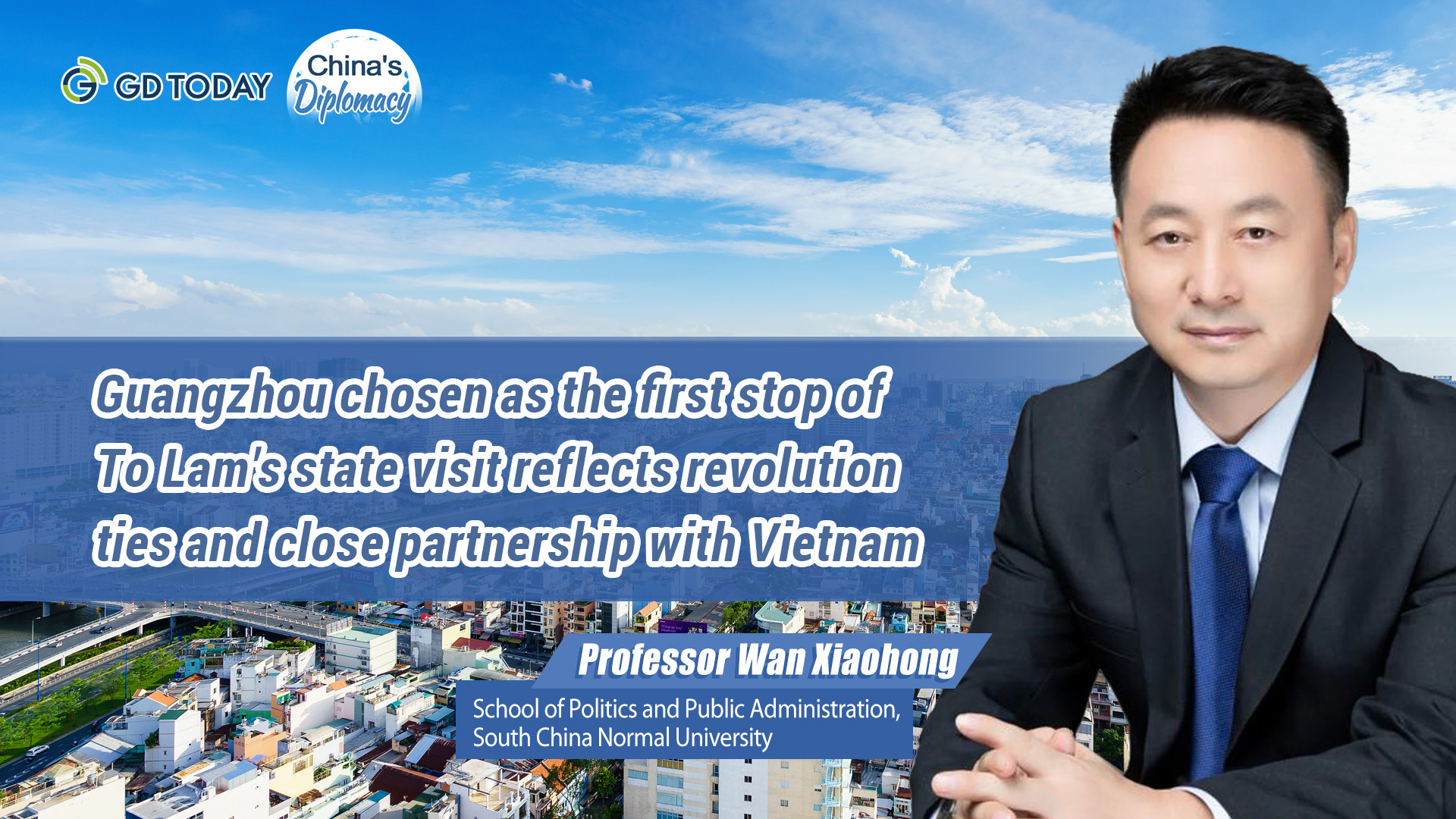On July 18, General Secretary of the Communist Party of Vietnam Central Committee and Vietnamese President To Lam arrived in Guangzhou as the first stop of his three-day state visit to China, before he headed for Beijing. This marks To Lam's first visit to China since he was elected as the top leader of the Southeast Asian nation in early August.
During his visit in Guangzhou, the top leader held a meeting with representatives of Chinese friendly people towards Vietnam.
Professor Wan Xiaohong, School of Politics and Public Administration, South China Normal University attended the meeting and shared his opinion about President Lam's visit.
In his opinion, To Lam selected China as the first destination for his state visit carries profound implications. As a continuation of the long-standing tradition of high-level visits between the two countries, the visit signals a strong will that Vietnam looks to strengthen bilateral relations with China.
Guangzhou, where Vietnamese Revolution started, holds close partnership with Vietnam
During To Lam's visit to China, Guangzhou was highlighted as the first stop of the trip. Professor Wan told us that the reasons can be traced in both historical and modern angles.
"Guangdong's provincial capital Guangzhou is historically the starting point of the Vietnamese revolution, and Ho Chi Minh, the father of Vietnam, left many revolutionary footprints there." Wan explained. To Lam also traced back here to see the revolutionary legacies left by Ho Chi Minh in China in his effort to lead the nation towards independence. This year also marks the 100th anniversary since President Ho Chi Minh started his revolutionary activities in Guangzhou.
To this date, Guangdong and Vietnam have built up strong economic ties due to practical cooperation in many areas. Such relations are genuinely valued by To Lam, Wan also mentioned.
Guangdong has long been Vietnam's largest provincial trading partner. In the year of 2023, the total trade between Guangdong and Vietnam reached 48.245 billion US dollars, which marked an increase of 7.9%. Specifically, Guangdong's export value to Vietnam totaled 25.349 billion US dollars, and Guangdong's import value from Vietnam totaled 22.896 billion US dollars.
From January to June 2024, the trade volume between Guangdong and Vietnam has amounted to 26.812 billion US dollars, an increase of 29.69% year-on-year. With To Lam's visit to China, it is foreseeable that a record will be set and mutually beneficial cooperation between Guangdong and Vietnam will enter a new stage.
Vietnam and China to reach greater consensus on enhancing economic ties
"To Lam's visit to China shows that on a strategic level, Vietnam, with its new leadership, wants to build mutual trust with China," Wan mentioned, "and with that in mind, there are ways to deepen our practical cooperation."
In the view of Professor Wan, China and Vietnam are complementary to each other economically. "Our trade volume has continued to rise, surpassing US $170 billion in 2023, and we have close cooperation in areas like agricultural products, machinery and equipment, electronic products."
"Due to an economic downturn back in 2022, many European and American brands decided to relocate their manufacturing bases from Vietnam." Professor Wan explained, "It is estimated that about 40,000 companies were forced to close down within a year." In order to recover its export market, Vietnam has formulated preferential investment policies to attract Chinese enterprises.
With the more RCEP measures in place, Wan thinks bilateral trade will be further expanded. He also noticed a steady inflow of Chinese investors in Vietnam. "On top of manufacturing, infrastructure and agriculture, Chinese enterprises are becoming more confident to invest in Vietnam in emerging fields. We see them in digital economy and green energy especially." said Professor Wan.
With the China-ASEAN Free Trade Agreement (CAFTA), the Regional Comprehensive Economic Partnership (RCEP) and the EU-Vietnam Free Trade Agreement (EVFTA), Chinese companies investing in Vietnam enjoy lower tariffs and their products are accessible to ASEAN market, Europe and other countries around the world. "At present, Vietnam has become one of the first choice for Chinese enterprises to 'go global'." Wan said.
People from Vietnam and China shares inseparable friendship
As this year marks the Year of ASEAN-China Year of People-to-people Exchanges, cultural exchange also plays a crucial part in deepening the comprehensive strategic partnership between the two countries, according to Wan.
Tourism and cultural exchange programs will be the major ways to bring Chinese and Vietnamese people closer. "We see a tourism boom between the two peoples this Labor's Day Holiday," Wan said, "the number of inbound and outbound passengers at Dongxing Port in Guangxi Zhuang Autonomous Region, China reached 101,200, and the number at Youyi Port in Vietnam reached 33,400." Wan thinks the number can and should continue to grow, if the two sides hold talks on liberalizing visa policies and improving supporting facilities for tourists.
In the aspect of higher education, Professor Wan is confident that the two countries will announce more pilot exchange or volunteer programs universities, and put together forums for higher education cooperation and exchanges.
Reporter: Jersey, Manqi(intern)
Editor: Steven, Nina, James
Poster: Jocelyn Cai

















